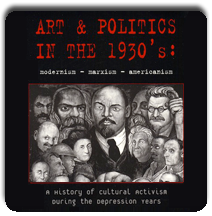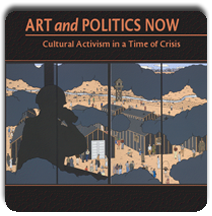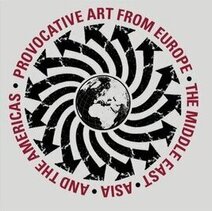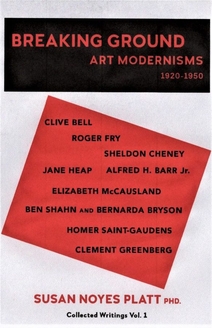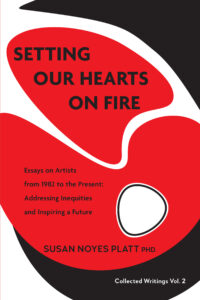Buster Simpson Town and Country Crier
“I believe artists’ work often functions as the equivalent of a town crier, calling out concepts in public. Traditionally the crier’s message is of civic or community importance, here we add construct. The Town and Country Crier exhibition presents a range of environmental and social issues. These issues often inform actions creating artwork that connects indicator, mitigator and story teller.” Buster Simpson
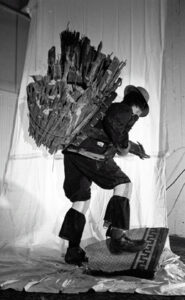
Buster Simpson ” Woodman”
In the 1970s Buster Simpson picked up pieces of wood off the street and at sites of building demolition.
![]()
![]() This photo is a recreation of that action.
This photo is a recreation of that action.
When Buster first arrived in Seattle his first exhibition was simply cleaning up a filthy warehouse where he was staying with a fellow artist Chris Jonic. The exhibition was titled “Selective Disposal Project”
Buster Simpson is idealistic and humourous but practical. He really wants to improve the environment and encourage us to to that also, but he has a good time doing it.

His recent exhibition at Slip Galllery in Belltown
“Town and Country Crier” is an appropriate place for Simpson to show his work. Belltown has been a focus of his work for many decades.
We are greeted at the door by a photo of the word purge written in chalk and glass bells with bronze clappers
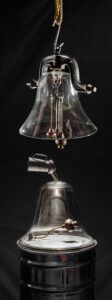
His themes are embodied in these works, purge referring to cleaning toxins out of water, and the bell points to his ironic sense of humor. It suggests an announcement is coming ( as in Town Crier calling attention fo an emergency. But if you actually ring this bell it will shatter. That takes our imaginations to where we are today. Emergency bells that can’t be heard.
The first gallery is a mini retrospective of his Belltown work with a team of collaborators planting trees on First Avenue. He included a document from that project.The diagram at t he bottom indicates where trees were to be planted ( many were); The project also included benches.
The handwritten document from the First Avenue Project identifies the larger issue at stake: working from and with community rather than top down through government mandates. The archival documents fill a wall.
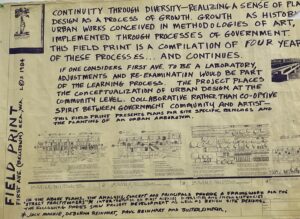
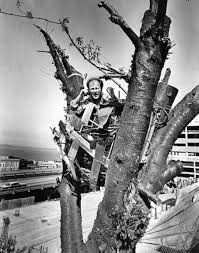
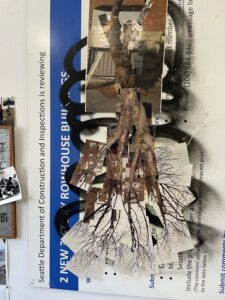
He stayed in one tree to protest its cutting down : the photograph of the upside down tree on the right is another truncated tree.
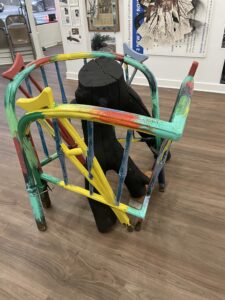
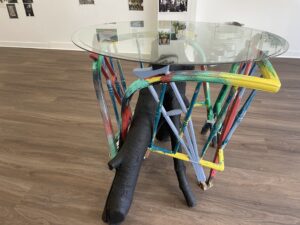
One long term project was to use iron bedsteads from SROs that were being torn down to protect the trees that he and others planted in Belltown.Here is a sad statement in the exhibition of the bedstead protecting a burned tree root. When I went back to the exhibition a second time, it was covered with a glass tabletop, which diluted the emotioinal immediacy of the bare black tree. Now it is protecting a small tree outside the gallery
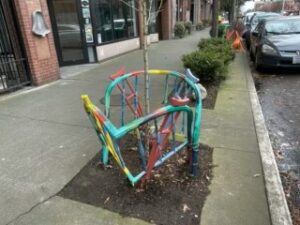
In this first gallery there are also references to two important ongoing projects,”When the Tide is Out the Table is Set”. This is a not at all amusing quote from Native Americans description of the Duwamish River before the white Man came. Now we have intense polution on that same river
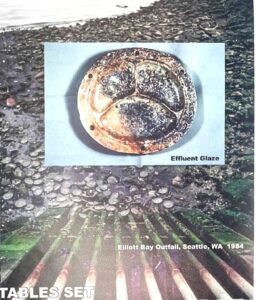
This dinner plate picked up pollution from being placed in Elliott Bay
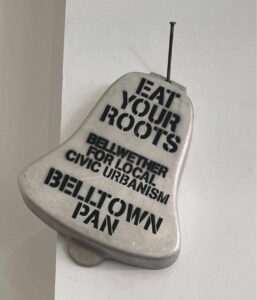
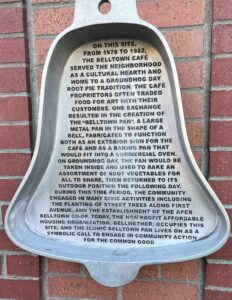 Another series of works are based on the bell shape made into a pan in which a community meal was cooked. The Belltown cafe was a community gathering place that traded food for art.
Another series of works are based on the bell shape made into a pan in which a community meal was cooked. The Belltown cafe was a community gathering place that traded food for art.Purge is a major theme Buster Simpson’s work. Many of his actions over the years have focused on detoxifying rivers. Here you see on the floor the limestone frog, whom Simpson said was an indicator species. The limestone frog when placed in water detoxifies the water, to the extent possible,
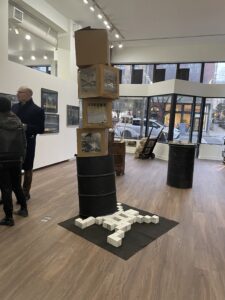
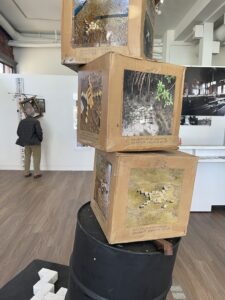
an action repeated in many places recorded in the stack of boxes. ( He mentioned that it was a special limestone found only in Texas, which I found amusing). Here is the frog in the Great Salt Lake which is of course disappearing.
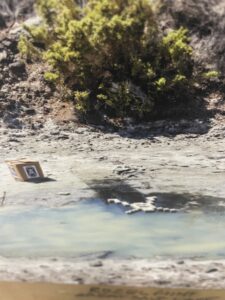
Another reference to toxins, in this case deadly, is a rusted oil barrel with a reference to the smallpox ridden rags that were passed on to Indians.
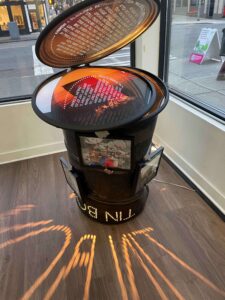
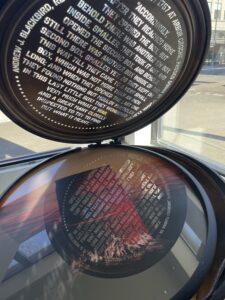
In this room there is also a complex and amusing multimedia piece referring to changing coastlines and climate change with a giant depth measure as well as a crucified haloed “figure” made from branches holding dipsticks. Across the front is a large level with monopoly pieces inside. Simpson’s specialty is multiple overlaid references to what he cares deeply about laced with humor.
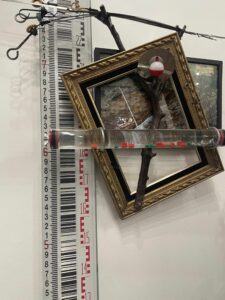

Simpson’s roots are in conceptual art, artists who didn’t believe in making objects for sale-instead they make gestures or draw plans. Simpson stands out because he continues to work with the real world and physical things, but always in a subversive and amusing way.
Brightwater watermolecule and pipe
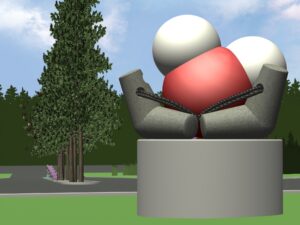
molecule

Brightwater Bio Boulevard
Simpson also works often with large committees and successfully completes projects such as the Brightwater Treatment Plan (with many other artists)
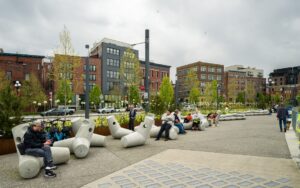
photograph by Joe Freeman
and the waterfront “Anthropocene Migration Stage” on the beach near Yesler. Simpson conceived it as a place to sit temporarily until the sea level requires it to migrate away from the waters. He frequently uses these concrete dolos . Dolos are also a metaphor:
“a wave-dissipating concrete block used in coastal management (dolosse), a personified spirit of trickery and guile in Greek mythology, and a source code plagiarism detection tool”
No wonder Simpson likes them!
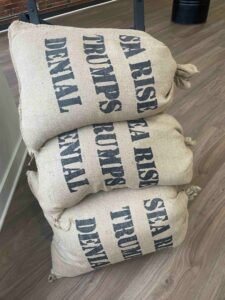
As we leave the gallery three bags filled with sand say “Searise Trumps Denial.”
A large sack of chalks invite us to take one and make our own protests in the street


